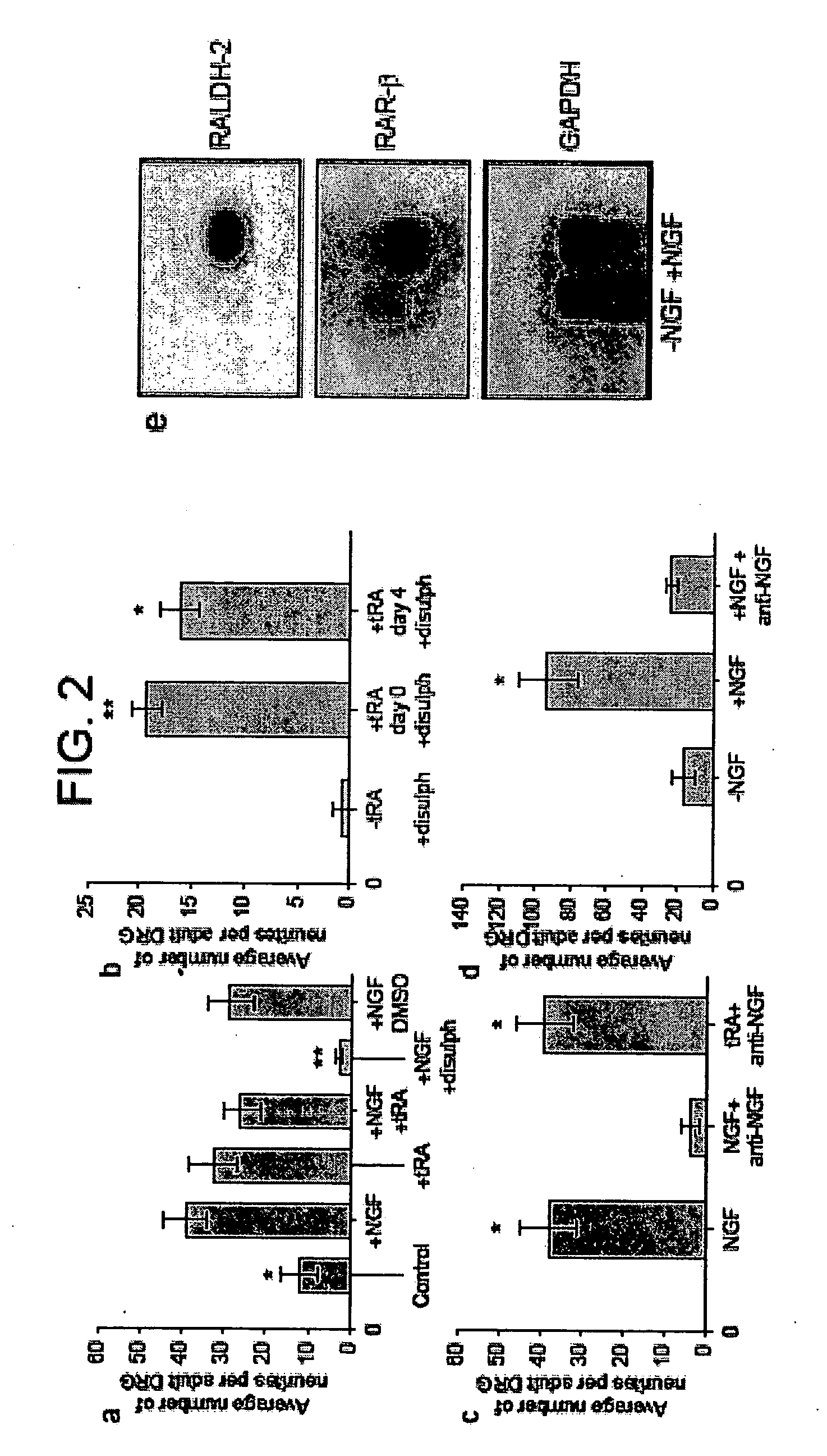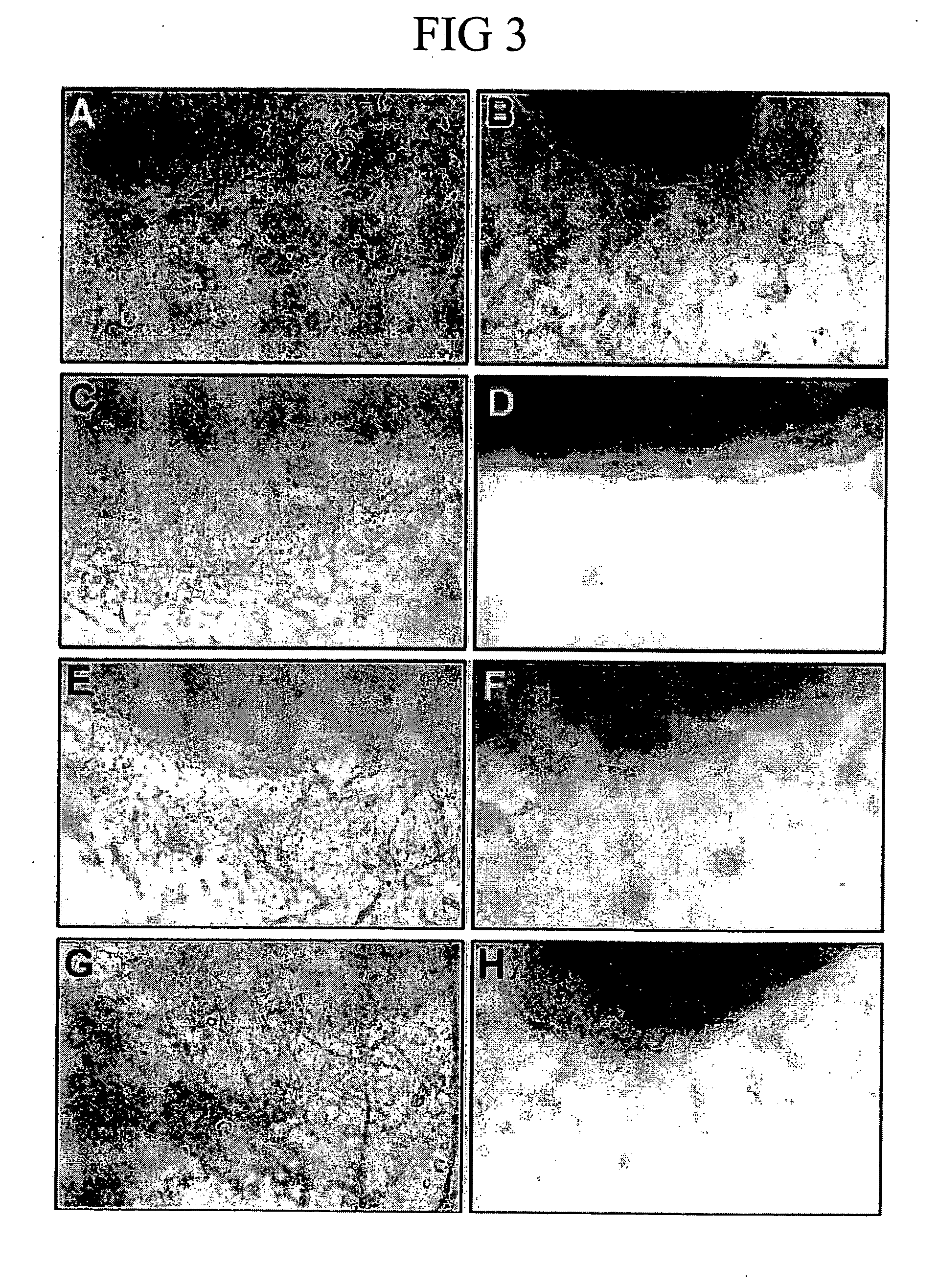Retinoic acid receptor beta-2, its agonists, and gene therapy vectors for the treatment of neurological disorders
a technology of retinoic acid receptor and gene therapy vector, applied in the field of factors, can solve the problems of difficult administration of ngf, ngf is susceptible to protease mediated degradation, and ngf is also relatively expensive to prepar
- Summary
- Abstract
- Description
- Claims
- Application Information
AI Technical Summary
Benefits of technology
Problems solved by technology
Method used
Image
Examples
example 1
Figures for Example 1
[0395]FIG. 1. Neurite outgrowth in adult mouse DRG cultured for five (a-d, g, h) or eight days (e, f) in the presence of delipidated serum plus: (a) no addition; (b) NGF, 100 ng per ml; (c) NGF and 100 nM tRA; (d) NGF and 10 M disulphiram; (e) disulphiram and tRA added on day 0; (f) disulphiram; (g) NGF and blocking antibody (h) NGF-blocking antibody and tRA.
[0396]FIG. 2. (a-c) Neurites produced by adult DRG cultured in cellogen. (a) Effects of NGF, RA and disulphiram at five days (1, no additive; 2, NGF, 100 ng per ml; 3, RA, 100 nM; 4, NGF, 100 ng per ml and RA, 100 nM; 5, 100 ng / ml NGF and 10 M disulphiram; 6, NGF, 100 ng per ml and DMSO). Error bars, s.e.; n=6, all groups. Differences between NGF-treated (2) and other groups: *p<0.01; **p<0.0001; Student's test (b) RA rescue of DRG treated with 10 M disulphiram (left to right: no RA; 100 nM RA, day 0; 100 nM RA, day 4) Error bars, s.e.; n=6, all groups. Differences from RA-absent cultures: *p<0.01, **p<0.00...
example 5
Production of EIAV Vector Genome Expressing RARβ2
[0471] A fragment of DNA encoding the retinoic acid receptor β2 is amplified by the polymerase chain reaction from a suitable template for RARβ2 such as cDNA produced from Trizol-prepared RNA as described in Example 2, or alternatively any nucleic acid molecule comprising RARβ2 such as described in Accession Number NM—000965. The oligonucleotide primers used are:
RARβ2 FWD:5′ CAG TAC ccg.cgg GCC ACC ATG TTT GACTGT ATG GAT GTT CTG 3′RARβ2 REV:5′ CAG TAC ctg cag.ATC ATT GCA CGA GTGGTG ACT GAC T 3′
[0472] The oligonucleotide primers contain SaclI and PstlI recognition sites respectively in order to facilitate cloning into the EIAV vector genome. In addition a Kozak sequence (GCCACC) is introduced upstream of the ATG initiation codon of the RARβ2 gene in RARβ2 FWD to improve the efficiency of translational initiation and the termination codon and context (in RARβ2 REV) is changed to UGAA which has been shown to be the most efficient term...
example 6
Transfer of Genetic Material to Non-Dividing Cells
[0491] This example demonstrates gene transfer to dorsal root ganglion (DRG), i.e., gene transfer to non-dividing neuronal cells, by the equine infectious anaemia virus vector, pONY8.0Z.
[0492] The EIAV vector, pONY8.0Z is made by transient co-transfection of HEK 293T human embryonic kidney cells with pONY8.0Z vector genome plasmid (FIGS. 30 and 31), pONY3.1 (FIGS. 32 and 33) (WO99 / 32646) and an envelope expression plasmid, pRV67 (FIGS. 34 and 35) (WO99 / 61639)(which encodes the vesicular stomatitis virus protein G, VSV-G) using the calcium phosphate precipitation method, as described below.
[0493] Vectors may also be produced according to the invention using different proteins capable of pseudotyping EIAV, such as Rabies G or variants of Rabies G (WO99 / 61639) (using pRabG plasmid or a variant such as pSA91 RbG plasmid) or VSV-G (using pRV67 plasmid) as described above. The method of production is as described above, except that a VS...
PUM
 Login to View More
Login to View More Abstract
Description
Claims
Application Information
 Login to View More
Login to View More - R&D
- Intellectual Property
- Life Sciences
- Materials
- Tech Scout
- Unparalleled Data Quality
- Higher Quality Content
- 60% Fewer Hallucinations
Browse by: Latest US Patents, China's latest patents, Technical Efficacy Thesaurus, Application Domain, Technology Topic, Popular Technical Reports.
© 2025 PatSnap. All rights reserved.Legal|Privacy policy|Modern Slavery Act Transparency Statement|Sitemap|About US| Contact US: help@patsnap.com



